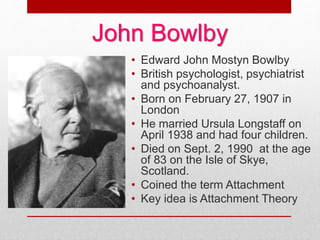John Bowlby
•Descargar como PPTX, PDF•
10 recomendaciones•9,502 vistas
Attachment Theory
Denunciar
Compartir
Denunciar
Compartir

Recomendados
Más contenido relacionado
La actualidad más candente
La actualidad más candente (20)
Destacado
Destacado (20)
Myers Briggs Type Indicator (MBTI) & Team Building

Myers Briggs Type Indicator (MBTI) & Team Building
Psychology: Harlow’s experiments on attachment in monkeys. by Janice Fung.

Psychology: Harlow’s experiments on attachment in monkeys. by Janice Fung.
Similar a John Bowlby
Similar a John Bowlby (7)
Más de MingMing Davis
Más de MingMing Davis (20)
Schizophrenia Spectrum and Other Psychotic Disorders

Schizophrenia Spectrum and Other Psychotic Disorders
Dissociative Disorders, Somatoform and Related Disorders

Dissociative Disorders, Somatoform and Related Disorders
Último
This presentation was provided by William Mattingly of the Smithsonian Institution, during the fourth segment of the NISO training series "AI & Prompt Design." Session Four: Structured Data and Assistants, was held on April 25, 2024.Mattingly "AI & Prompt Design: Structured Data, Assistants, & RAG"

Mattingly "AI & Prompt Design: Structured Data, Assistants, & RAG"National Information Standards Organization (NISO)
Último (20)
Measures of Dispersion and Variability: Range, QD, AD and SD

Measures of Dispersion and Variability: Range, QD, AD and SD
Mattingly "AI & Prompt Design: Structured Data, Assistants, & RAG"

Mattingly "AI & Prompt Design: Structured Data, Assistants, & RAG"
Unit-IV; Professional Sales Representative (PSR).pptx

Unit-IV; Professional Sales Representative (PSR).pptx
Basic Civil Engineering first year Notes- Chapter 4 Building.pptx

Basic Civil Engineering first year Notes- Chapter 4 Building.pptx
Z Score,T Score, Percential Rank and Box Plot Graph

Z Score,T Score, Percential Rank and Box Plot Graph
SECOND SEMESTER TOPIC COVERAGE SY 2023-2024 Trends, Networks, and Critical Th...

SECOND SEMESTER TOPIC COVERAGE SY 2023-2024 Trends, Networks, and Critical Th...
John Bowlby
- 1. John Bowlby • Edward John Mostyn Bowlby • British psychologist, psychiatrist and psychoanalyst. • Born on February 27, 1907 in London • He married Ursula Longstaff on April 1938 and had four children. • Died on Sept. 2, 1990 at the age of 83 on the Isle of Skye, Scotland. • Coined the term Attachment • Key idea is Attachment Theory
- 2. Attachment theory in psychology originates with the seminal work of John Bowlby (1958). In the 1930’s John Bowlby worked as a psychiatrist in a Child Guidance Clinic in London, where he treated many emotionally disturbed children. This experience led Bowlby to consider the importance of the child’s relationship with their mother in terms of their social, emotional and cognitive development. Specifically, it shaped his belief about the link between early infant separations with the mother and later maladjustment, and led Bowlby to formulate his attachment theory.
- 3. What is Attachment? • Attachment can be defined as a unique emotional bond between caregiver and a child that involves an exchange of comfort, care and pleasure. The roots of attachment began with Freud's theories about love, however John Bowlby's research usually credits him as the, “father of attachment”.
- 4. Bowlby described it as a “lasting psychological connectedness between human beings.” Bowlby believed that mental health and behavioral problems could be attributed to early childhood. He suggested that children come into the world biologically pre-programmed to form attachments with others because this will help them to survive.
- 5. Bowlby believed that attachment behaviors are instinctive and will be activated by any conditions that seem to be threaten the achievement of proximity, such as separation, insecurity and fear. He also postulated that the fear of stranger represents an important survival mechanism, built in by nature. Babies are born with the tendency to display certain innate behaviors called social releasers which help ensure proximity and contact with the mother or attachment figure.
- 6. Main Points of Bowlby’s Theory 1. A child has an innate need to attach to one main attachment figure. 2. A child should receive the continuous care of this single most important attachment figure for approximately the first two years of life. 3. The long term consequences of maternal deprivation might include the following. • Delinquency • Reduced intelligence • Increased aggression • Depression • Affectionless psychopathy
- 7. 4. Bowlby believed that short term separation from an attachment figure leads to distress. They found 3 progressive stages for distress: A. Protest – The child cries, screams and protests angrily when the parent leaves. They will try to cling to the parent to stop them leaving. B. Despair – The child’s protesting begins to stop and they appear to be calmer although still upset. The child refuses others’ attempts for comfort and often seems withdrawn and uninterested in anything.
- 8. C. Detachment – If separation continues the child will start to engage with other people again. They will reject the caregiver on their return and show strong signs of anger. 5. The child’s attachment relationship with their primary caregiver leads to the development of an internal working model. There are 3 main features of the internal working model. 1. A model of others as being trustworthy 2. A model of self as valuable 3. A model of the self as effective interacting with others.
- 9. Characteristics of Attachment Proximity Maintenance The desire to be near the people we are attached to. Safe Haven Returning to the attachment figure for comfort and safety in the face of a fear or threat. Secure Base The attachment figure acts as a base of security from which the child can explore the surrounding environment. Separation Distress or Anxiety Anxiety that occurs in the absence of the attachment.
